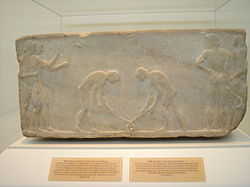Etymology
The first recorded use of the word hockey is in the 1773 book Juvenile Sports and Pastimes, to Which Are Prefixed, Memoirs of the Author: Including a New Mode of Infant Education by Richard Johnson (Pseud. Master Michel Angelo), whose chapter XI was titled "New Improvements on the Game of Hockey". [1] The belief that hockey was mentioned in a 1363 proclamation by King Edward III of England [2] is based on modern translations of the proclamation, which was originally in Latin and explicitly forbade the games "Pilam Manualem, Pedivam, & Bacularem: & ad Canibucam & Gallorum Pugnam". [3] [4] The English historian and biographer John Strype did not use the word "hockey" when he translated the proclamation in 1720, instead translating "Canibucam" as "Cambuck"; [5] this may have referred to either an early form of hockey or a game more similar to golf or croquet. [6] The word hockey itself is of unknown origin. One supposition is that it is a derivative of hoquet, a Middle French word for a shepherd's stave. [7] The curved, or "hooked" ends of the sticks used for hockey would indeed have resembled these staves, and similar folk etymologies exist for the bat-and-ball sports of Croquet and Cricket. Another supposition derives from the known use of cork bungs (stoppers), in place of wooden balls to play the game. The stoppers came from barrels containing "hock" ale, also called "hocky". [8]
Modern usage
In most of the world, the term hockey when used without clarification refers to field hockey, while in Canada, the United States, Russia and most of Eastern and Northern Europe, the term usually refers to ice hockey. [9] In more recent history, the word "hockey" is used in reference to either the summer Olympic sport of field hockey, which is a stick and ball game, and the winter ice team skating sports of bandy and ice hockey. This is because field hockey and other stick and ball sports and their related variants preceded games which would eventually be played on ice with ice skates, namely bandy and ice hockey, as well as sports involving dry floors such as roller hockey and floor hockey. However, the "hockey" referred to in common parlance often depends on locale, geography, and the size and popularity of the sport involved. For example, in Europe, "hockey" more typically refers to field hockey, whereas in Canada, it typically refers to ice hockey. In the case of bandy, the game was initially called "hockey on the ice" and preceded the organization and development of ice hockey, but was officially changed to "bandy" in the early 20th century in order to avoid confusion with ice hockey, a separate sport. Bandy, while related to other hockey games, derives some of its inspiration from Association football.
- In most of the world, the term hockey when used without clarification refers to field hockey
- The word "hockey" in Canada, the United States, Russia, and most of Eastern and Northern Europe, typically refers to ice hockey





































